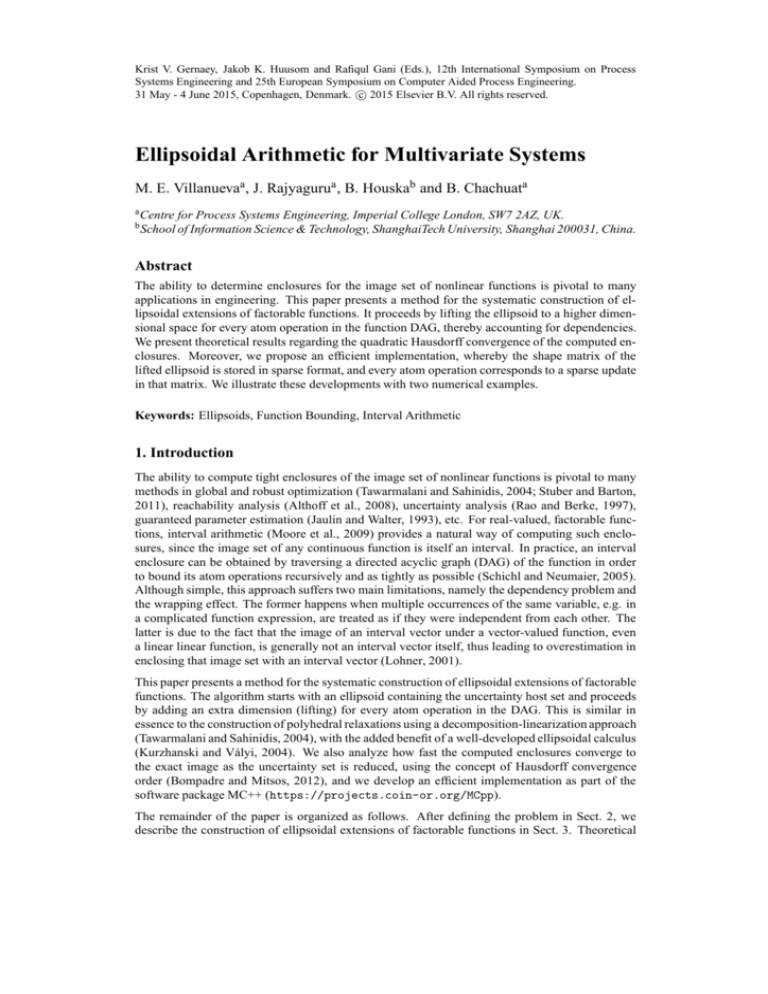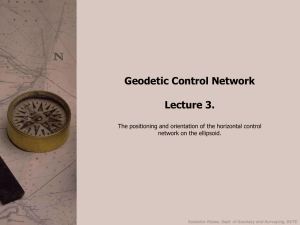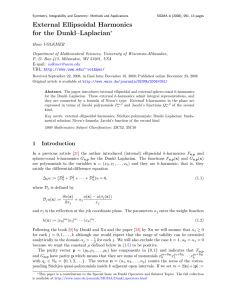
Krist V. Gernaey, Jakob K. Huusom and Rafiqul Gani (Eds.), 12th International Symposium on Process
Systems Engineering and 25th European Symposium on Computer Aided Process Engineering.
c 2015 Elsevier B.V. All rights reserved.
31 May - 4 June 2015, Copenhagen, Denmark. Ellipsoidal Arithmetic for Multivariate Systems
M. E. Villanuevaa, J. Rajyagurua , B. Houskab and B. Chachuata
a Centre
b
for Process Systems Engineering, Imperial College London, SW7 2AZ, UK.
School of Information Science & Technology, ShanghaiTech University, Shanghai 200031, China.
Abstract
The ability to determine enclosures for the image set of nonlinear functions is pivotal to many
applications in engineering. This paper presents a method for the systematic construction of ellipsoidal extensions of factorable functions. It proceeds by lifting the ellipsoid to a higher dimensional space for every atom operation in the function DAG, thereby accounting for dependencies.
We present theoretical results regarding the quadratic Hausdorff convergence of the computed enclosures. Moreover, we propose an efficient implementation, whereby the shape matrix of the
lifted ellipsoid is stored in sparse format, and every atom operation corresponds to a sparse update
in that matrix. We illustrate these developments with two numerical examples.
Keywords: Ellipsoids, Function Bounding, Interval Arithmetic
1. Introduction
The ability to compute tight enclosures of the image set of nonlinear functions is pivotal to many
methods in global and robust optimization (Tawarmalani and Sahinidis, 2004; Stuber and Barton,
2011), reachability analysis (Althoff et al., 2008), uncertainty analysis (Rao and Berke, 1997),
guaranteed parameter estimation (Jaulin and Walter, 1993), etc. For real-valued, factorable functions, interval arithmetic (Moore et al., 2009) provides a natural way of computing such enclosures, since the image set of any continuous function is itself an interval. In practice, an interval
enclosure can be obtained by traversing a directed acyclic graph (DAG) of the function in order
to bound its atom operations recursively and as tightly as possible (Schichl and Neumaier, 2005).
Although simple, this approach suffers two main limitations, namely the dependency problem and
the wrapping effect. The former happens when multiple occurrences of the same variable, e.g. in
a complicated function expression, are treated as if they were independent from each other. The
latter is due to the fact that the image of an interval vector under a vector-valued function, even
a linear linear function, is generally not an interval vector itself, thus leading to overestimation in
enclosing that image set with an interval vector (Lohner, 2001).
This paper presents a method for the systematic construction of ellipsoidal extensions of factorable
functions. The algorithm starts with an ellipsoid containing the uncertainty host set and proceeds
by adding an extra dimension (lifting) for every atom operation in the DAG. This is similar in
essence to the construction of polyhedral relaxations using a decomposition-linearization approach
(Tawarmalani and Sahinidis, 2004), with the added benefit of a well-developed ellipsoidal calculus
(Kurzhanski and Vályi, 2004). We also analyze how fast the computed enclosures converge to
the exact image as the uncertainty set is reduced, using the concept of Hausdorff convergence
order (Bompadre and Mitsos, 2012), and we develop an efficient implementation as part of the
software package MC++ (https://projects.coin-or.org/MCpp).
The remainder of the paper is organized as follows. After defining the problem in Sect. 2, we
describe the construction of ellipsoidal extensions of factorable functions in Sect. 3. Theoretical
2
M. E. Villanueva et al.
results regarding the Hausdorff convergence of the computed enclosures are presented in Sect. 4.
Then, we discuss important implementation details in Sect. 5, and illustrate mitigation of both the
dependency and wrapping effects with numerical examples. Finally, Sect. 6 concludes the paper.
Notation. Besides standard mathematical notation, the diameter of a compact set Z ⊆ Rn is
defined by diam(Z) = maxz1,z2∈Z kz1 − z2 k. The Minkowski sum of two compact sets Z,W is
W ⊕ Z := {w + z | w ∈ W, z ∈ Z}. If W ⊆ Z the Hausdorff metric between these sets is given by
dH (W, Z) := maxz∈Z minw∈W kw − zk. An n-dimensional ellipsoid is defined as:
n
o
1 E (q, Q) := q + Q 2 v ∀v ∈ Rn , v⊺ v ≤ 1 ∈ En ,
where En denotes the class of n-dimensional ellipsoids, the vector q ∈ Rn and the positive semidefinite matrix Q ∈ Sn+ are respectively the center and the shape matrix of the ellipsoid.
2. Problem Formulation
Consider a function f : Rnx → Rn f , with its argument x ∈ Rnx contained in the ellipsoid E (qx , Qx ) ∈
Enx . The exact image of E (qx , Qx ) under the function f is defined as
f (E (qx , Qx )) := { f (x) | x ∈ E (qx , Qx )} .
(1)
The main focus of this paper is on computing an enclosure of the image set of f in the form of an
n
ellipsoid E (q f , Q f ); that is, E (q f , Q f ) ⊇ f (E (qx , Qx )) with (q f , Q f ) ∈ Rn f × S+f .
The main assumption we make to enable this construction is that the function f must be factorable,
i.e. it can be decomposed into a finite number N of atom operations ai from a finite library, such
as binary addition, binary product, and outer composition with a univariate function. In particular,
factorable functions can be evaluated by setting u0 (x) = x and applying the recursive rule
i−1
u (x)
i
i−1
,
(2)
∀i ∈ {1, . . ., N}, u (x) = gi (u (x)) :=
ai (ui−1 (x))
so that f (x) = PuN (x) = P[gN ◦ gN−1 ◦ . . . ◦ g1 ](x), where P ∈ Rn f ×(nx +N) is a projection matrix selecting the appropriate components. The j-th component of ui (x) is denoted as uij (x) subsequently.
The main problem addressed in this paper is the development of a constructive approach for an
ellipsoidal extension f E : Enx → En f of the factorable function f , whose image f E (qx , Qx ) yields
the ellipsoidal enclosure, E(q f , Q f ) := f E (qx , Qx ) ⊇ f (E (qx , Qx )).
3. Ellipsoidal Arithmetic for Factorable Functions
The proposed algorithm proceeds by lifting the ellipsoid to a higher dimensional space for every
atom operation in the function’s DAG upon application of an ellipsoidal arithmetic. Starting with
an ellipsoid E (q0 , Q0 ) ∈ Enx with q0 := qx and Q0 := Qx , an ellipsoidal extension of each factor
gi , i = 1, . . . , N is obtained such that gEi (E (qi−1 , Qi−1 )) = E (qi , Qi ), with
⊺
i−1 Ii−1
q
i−1 Ii−1
i
i
.
(3)
Q
and Q :=
q :=
Λi
Λi
λi
Here, Ii−1 ∈ R(nx +i−1)×(nx +i−1) denotes the identity matrix; and the lifting parameters λ i ∈ R and
Λi ∈ Rnx +i−1 (row vector) depend on the functional form of the corresponding atom operation ai .
At the end, the ellipsoidal extension f E of f is retrieved by projecting the lifted ellipsoid
E (qN , QN ) ∈ Enx +N onto Rn f , giving
f E (qx , Qx ) := E (q f , Q f ) = P × E (qN , QN ) .
The following two subsections describe ways that such lifting parameters can be constructed for
both linear and nonlinear atom operations.
Ellipsoidal Arithmetic for Nonlinear Vector-Valued Functions
3
3.1. Affine Atom Operations
Consider those operations ui (x) := gi (ui−1 (x)), where the atom operation ai is an affine function
i−1
of at most two factors ui−1
k (x), um (x) with k, m ≤ i − 1. This corresponds to the case of addition,
subtraction, scaling and shifting.
i−1
Addition and Subtraction Operations, ui−1
k (x) ± um (x). The lifting parameters are given by:
λ :=
i
i−1
qi−1
k ± qm
1
i
and Λ j := ±1
0
if j = k,
if j = m,
otherwise.
Scaling Operation, α ui−1
k (x) for some α ∈ R. The lifting parameters are given by:
(
α if j = k,
i
i−1
i
λ := qk
and Λ j :=
0 otherwise.
Shifting Operation, ui−1
k (x) + β for some β ∈ R. The lifting parameters are given by:
(
1 if j = k,
i
i
i−1
λ := qk + β and Λ j :=
0 otherwise.
(4)
(5)
(6)
3.2. Nonlinear Atom Operations
Consider the operation ui (x) = gi (ui−1 (x)), where the atom operation ai is a possible nonlinear
function of the sole factor ui−1
k (x) with k ≤ i − 1 first. Note that the domain Di ⊆ R of ai is
given by
the
projection
of
the
ellipsoid E (qi−1 , Qi−1 ) onto its k-th component, given by Di :=
q
Qi−1
qi−1
k,k [−1, 1]. In particular, we make the assumptions that: (i) Di is included within the
k +
domain of definition of ai throughout—this is relevant, for instance, for the univariate functions
√
z 7→ log(z), z 7→ 1/z, z 7→ z, etc; and (ii) the function ai is Lipschitz continuous.
One way of handling the nonlinear factor gi involves constructing a linear estimator such that
{0i−1 }
ν
Ii−1
0i−1
i−1
i−1
∀ν ∈ E (q , Q ), gi (ν ) :=
∈
+ i ⊺ ν ⊕
, (7)
[−δ i , δ i ]
ai (ν )
γ0i
γ1 ek
whereby the scalars γ0i , γ1i and δ i can be derived, for instance, from a Taylor model or, better, a
Chebyshev model of order q ≥ 1 of the atom operation ai on Di (Neumaier, 2003; Rajyaguru et al.,
2014); the latter is more advantageous in that it can be applied to nonsmooth atom operations, too.
In (7), ek stands for the kth basis vector and 0i−1 is a zero vector of size i − 1.
The lifting operation proceeds in two steps. In the first step, the linear part of (7) is absorbed into
the a lifted ellipsoid E (qi , Q̃i ) in a procedure that is similar to the one used for shifting and scaling
in (5)-(6), here with the lifting parameters
(
γ i / rad(Di ) if j = k,
i
i
i
(8)
λ := γ0 and Λ j := 1
0
otherwise.
In the second step the interval [−δ i , δ i ] which encloses the nonlinearity is added to the ith component of the lifted ellipsoid, in the Minkowski sense. Since the set of n-dimensional ellipsoids is
not closed under Minkowski addition, we use an ellipsoidal extension of the Minkowski sum so
4
M. E. Villanueva et al.
that E (qi , Qi ) := E (qi , Q̃i ) ⊕E E (∆i ), with ∆i := (δ i )2 (ei e⊺i ) ∈ Snx +i . In particular, we compute the
shape matrix Qi as
q
Tr Q̃i−1 + ε
1 i 1 i
i
Q := Q̃ + ∆ with µ0 = 1 − µ1 = q
.
(9)
p
µ0
µ1
Tr Q̃i−1 + ε + Tr (∆i ) + ε
Finally, in the case of binary product operations, the atom operation ai is a bilinear term between
i−1
two factors ui−1
k (x), um (x) with k, m ≤ i−1. Of the possible ways to yield an ellipsoidal enclosure
of bilinear terms, we use a simple DC-decomposition approach here. After rewriting the bilinear
term in the form
i−1
ui−1
k (x) × um (x) =
1 i−1
2
i−1
i−1
2
(uk (x) + ui−1
m (x)) − (uk (x) − um (x)) ,
4
(10)
we can apply recursively the rules of binary addition/subtraction and univariate composition for the
square function z 7→ z2 , as explained earlier. As an alternative, and potentially tighter, approach,
one can envisage the use of semi-definite programming (SDP) to handle bilinear terms.
4. Convergence Analysis
We now turn our attention to analyzing the theoretical convergence properties of the ellipsoidal
arithmetic presented in the previous section. An ellipsoidal extension f E of f is said to have
Hausdorff convergence order q ≥ 1 on Enx if
dH f E (E (qx , Qx )), f (E (qx , Qx ))) ≤ O(diam(E (qx , Qx ))q ) ,
(11)
for every domain E (qx , Qx ) ∈ Enx with sufficiently small diameter where f E is defined. The
following result relates the convergence order of a factorable function to the convergence order
of its atom operations.
Theorem 1. If all the atom operations ai in the DAG of a factorable function f are Lipschitz
continuous and their ellipsoidal extensions have image Hausdorff convergence order q, then the
ellipsoidal extension of f itself has image Hausdorff convergence q.
Proof. The result follows by finite induction over the atom operations, using the triangle inequality
for the Hausdorff metric dH and the Lipschitz continuity of each atom operation ai .
We now present the main result of this section.
Theorem 2. Let all the atom operations ai in the DAG of a factorable function f be twicecontinuously differentiable, and consider the ellipsoidal extension f E of f as constructed from
the lifting procedure in Sect. 3. Then, f E has quadratic Hausdorff convergence on Enx .
Proof. We show that the ellipsoidal extension of each atom operation have quadratic Hausdorff
convergence, so the result follows from Theorem 1 with q = 2. Since the class of ellipsoids is
closed under affine transformations, all the extensions for affine atom operations in Sect. 3.1 are
exact, and hence have infinite Hausdorff convergence order. Since binary product operations are
handled by a combination of affine operations and univariate nonlinear operations, the Hausdorff
convergence order of the extension f E is completely determined by the Hausdorff convergence
order of the latter. Consider the operation gi (ui−1 (x)) where the atom operation ai is a nonlinear
function of the sole factor ui−1
k (x) with k ≤ i − 1, and assume without loss of generality that
E (qi−1 , Qi−1 ) is centered at zero (mainly for notation simplicity). By construction of gEi and
Ellipsoidal Arithmetic for Nonlinear Vector-Valued Functions
5
invariance of ellipsoids under affine transformations, the ellipsoidal approximation E (Q̃i ) matches
the exact image of the linear part in (7). The exact image of the corresponding residual term is
Ii−1
0i−1
i−1
Γ := gi (ν ) −
+ i ⊺ ν ν ∈ E(Q ) .
γ0i
γ1 ek
Then, we have:
dH E (Qi ), gi (E (Qi−1 )) = dH E (Q̃i ) ⊕E E (∆i ), E (Q̃i ) ⊕ Γ
≤ dH E (Q̃i ) ⊕E E (∆i ), E (Q̃i ) + dH E (Q̃i ), E (Q̃i ) ⊕ Γ)
≤ dH E (Q̃i ) ⊕E E (∆i ), E (Q̃i ) + O (diam (Γ))
≤ O diam E (∆i ) + O (diam (Γ)) ,
where the last inequality follows from the definition of the ellipsoidal extension of the Minkowski
sum in (9). The result is obtained by noting that
and diam E (∆i ) ≤ O diam(E (Qi−1 ))2 ,
diam (Γ) ≤ O diam(E (Qi−1 ))2
by the assumption that gi is twice-continuously differentiable and by the Lipschitz-continuity of
natural interval extensions, respectively.
5. Numerical Implementation and Numerical Examples
Although simple, the algorithm describe in Sect. 3 is not the most effective way to implement
the ellipsoidal arithmetic. Firstly, the number of atom operations N in the DAG of a factorable
function is known a priori, which allows preallocation of the center vector and shape matrix. The
second observation is that the lifting operation defined in (3) corresponds to an update in the ith
i−1
row of the shape matrix; for instance, for an addition or subtraction operation ui−1
k (x) ± um (x):
(
Qik,k ± 2Qik,m + Qim,m if j = 1,
i
∀ j ∈ {0, . . . , i}, Qi, j =
Qik, j ± Qim, j
otherwise.
Therefore, an efficient implementation is possible, whereby the (symmetric) shape matrix of the
lifted ellipsoid is stored in sparse format and every atom operation corresponds to a sparse update
of the shape matrix. Such an implementation of the ellipsoidal arithmetic is available as part of
the software package MC++ (https://projects.coin-or.org/MCpp).
We illustrate the benefits of ellipsoidal arithmetic compared with traditional interval arithmetic for
two problems. The left plot in Fig. 1 considers the following factorable function with nx = n f = 2,
√
f2 (x1 , x2 ) = (x1 − x2 )2 + 3x2 .
f1 (x1 , x2 ) = x1 + x2 + x1 x2
The comparison between the actual image set and the corresponding
interval
and
ellipsoidal ex3
2 1
tensions, here for a variable host set E (qx , Qx ) with qx =
and Qx =
, illustrates the
4
1 2
potential of ellipsoidal arithmetic to mitigate the dependency problem.
The right plot of Fig. 1 shows the solution set of the parametric linear ODE (harmonic oscillator)
ẋ1 (t) = x2 (t) + p ,
ẋ2 (t) = −x1 (t) + p ,
with joint ellipsoidal host set E (qx,p , Qx,p ) for the initial states x1 (0), x2 (0) and the parameter
p given by qx,p = (1 0 0)⊺ and Qx,p = 0.01 I3 . The unconditional stability of the reach tube
illustrates the ability of ellipsoidal arithmetic to mitigate the wrapping effect, which is due to the
property of invariance under affine transformations of ellipsoids.
6
M. E. Villanueva et al.
35
1.5
30
1
0.5
f2
25
x2
20
0
-0.5
15
-1
-1.5
-1.5
10
-1
-0.5
5
0
5
10
15
f1
20
25
30
x1
0
0.5
1
1.50
2
4
8
6
10
12
t
Figure 1: Left plot: Mitigation of the dependency problem using ellipsoidal arithmetic compared
with interval arithmetic for a factorable function; Right plot: Mitigation of the wrapping effect by
the property of invariance under affine transformation of ellipsoids for a parametric ODE.
6. Conclusion
This paper was concerned with the construction of ellipsoidal enclosures for the image set of factorable functions. Our approach provides such enclosures by traversing a DAG of the function,
and it applies an ellipsoidal arithmetic that lifts the ellipsoid to a higher dimensional space for
every atom operation. We have shown that this arithmetic yields quadratically convergent ellipsoidal extensions under mild assumptions, and that it can be implemented efficiently on account of
sparsity. In practice, quadratic Hausdorff convergence is a very desirable property in branch-andbound search for global optimization in order to reduce the cluster effect, as well as in the design
of validated integrators for asymptotically stable systems. Further research is needed in order to
extend existing interval-based algorithms to ellipsoidal techniques nonetheless.
Acknowledgments. Financial support from Marie Curie under grant PCIG09-GA-2011-293953 is gratefully
acknowledged. JR thanks EPSRC and the Department of Chemical Engineering at Imperial College for
doctoral training award. MV thanks CONACYT for doctoral scholarship.
References
Althoff, M., Stursberg, O., Buss, M., 2008. Reachability analysis of nonlinear systems with uncertain parameters using
conservative linearization. In: 47th IEEE Conference on Decision and Control, pp. 4042–4048.
Bompadre, A., Mitsos, A., 2012. Convergence rate of McCormick relaxations. Journal of Global Optimization 52 (1),
1–28.
Jaulin, L., Walter, E., 1993. Guaranteed nonlinear parameter estimation from bounded-error data via interval analysis.
Mathematics and Computers in Simulation 35 (2), 123–137.
Kurzhanski, A. B. and Vályi, I., 1994. Ellipsoidal Calculus for Estimation and Control. Birkhäuser, Boston.
Lohner, R. J., 2001. On the ubiquity of the wrapping effect in the computation of error bounds. In: Kulisch, P. D. U.,
Lohner, P. D. R., Facius, D. A. (Eds.), Perspectives on Enclosure Methods. Springer Vienna, pp. 201–216.
Moore, R. E., Kearfott, R. B., Cloud, M. J., 2009. Introduction to Interval Analysis. SIAM.
Neumaier, A., 2003. Taylor Forms—Use and limits. Reliable Computing 9 (1), 43–79.
Rajyaguru, J., Villanueva, M. E., Houska, B., Chachuat, B., 2014. Higher-Order Inclusions of Nonlinear Systems By
Chebyshev Models. In: AIChE Annual Meeting 2014, paper 566f.
Rao, S. S., Berke, L., 1997. Analysis of uncertain structural systems using interval analysis. AIAA Journal 35 (4),
727–735.
Schichl, H., Neumaier, A., 2005. Interval analysis on directed acyclic graphs for global optimization. Journal of Global
Optimization 33 (4), 541–562.
Stuber, M. D., Barton, P. I., 2011. Robust simulation and design using semi-infinite programs with implicit functions.
International Journal of Reliability and Safety 5 (3), 378–397.
Tawarmalani, M., Sahinidis, N. V., 2004. Global optimization of mixed-integer nonlinear programs: A theoretical and
computational study. Mathematical Programming 99 (3), 563–591.











